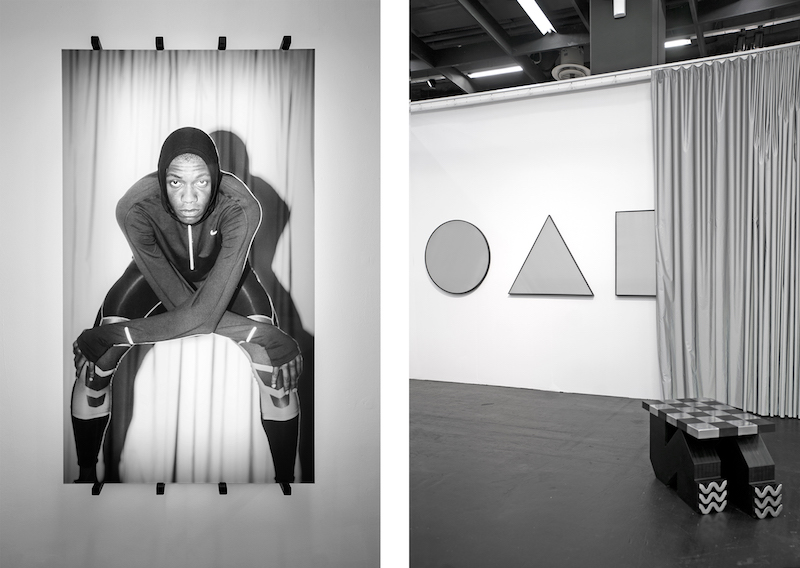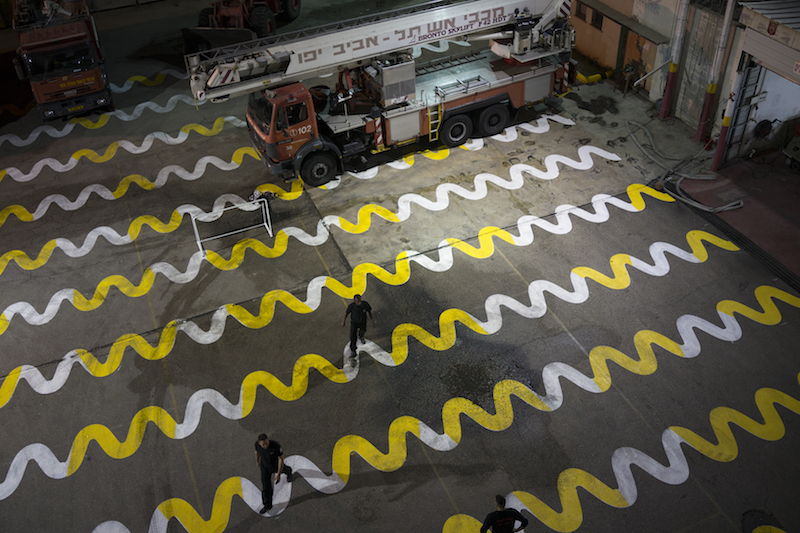 Installation view The curves of Jaffa, 2017; Photo: Alona Rodeh, Commissioned by Tel Aviv Municipality Arts Department
Installation view The curves of Jaffa, 2017; Photo: Alona Rodeh, Commissioned by Tel Aviv Municipality Arts Department
The screaming sound of a siren transforms into a beating sound of deep techno, light is flickering, we are underground, maybe in a club, maybe in a train, some men are staring into our eyes, a fire fighter shows his muscles, his clothes are reflecting in the light, almost blinding our sight. The curtain closes, the scene is over, the sudden absence of techno beats leaves us only with the bright architecture of the space that we know so well by night and so little by day. – Welcome to the aesthetic universe of Israeli and Berlin-based artist Alona Rodeh, who knows better than anyone how to to play the acoustic and visual keyboard of safety.
Anna-Lena Werner: "Safe and Sound" is a series of works that you have been producing…
Alona Rodeh: ...yes, “Safe and Sound” is what I call a meta-title with various sub-projects. It's about the aesthetics of safety, or maybe more precisely – visual expressions of safety.
ALW: How are the aesthetics of safety related to issues of state security in your work?
AR: In German that would be one word – "Sicherheit" – but safety and security are two different concepts. My interest comes from the urban sphere: people’s personal need to protect themselves, and state regulations on top, shedding light on a subject I am personally obsessed with. It is in fact an obsession of the western world, trying to make it safer and re-shaping it on the way.
ALW: The aesthetics of safety reappear through many different elements in your practice: In high visibility clothing, flickering lights and prominently the sound of alarms and sirens, about which you even give lectures. Is the alarm the aural embodiment of safety?
AR: You could say that. What I dug into and found interesting is the parallel evolution of alarms in emergency services and in music. From experiments in early 20th century by modernists such as Erik Satie and Edgard Varèse, through reggae and early hip hop, up until today, when sirens are being regularly sampled and overused in pop and techno. At the same time sirens arw being overused by police cars, ambulances, smartphones, smoke detectors or kids toys.
ALW: You video work "Barking Dogs don't Bite" refers to the alarm as a sound that seems to have become so present in Israel's everyday life that it has lost its urgency. Has effect of alarms inverted in the sense that it gives people comfort these days?
 Installation view Barking Dogs Don’t Bite, 2012; Photo: Tal Nisim
Installation view Barking Dogs Don’t Bite, 2012; Photo: Tal Nisim
AR: Actually the film is more about alarms used in commercial buildings. When I moved to Tel Aviv we lived in this pretty industrial area and there were nights when the alarms just didn’t stop. Later I realised that in the 90’s and 2000’s alarms were polluting the cities until they became counter-productive. Today these systems are smarter. The video work is more about burglary alarms than about the alarms of war. Air raid sirens are another thing that is taken very seriously, since they are almost never false alarms. They have a completely different sound: the air raid sirens are long and deep, like wind going through the buildings.
ALW: You did a residency at a fire station in Berlin and subsequently made a movie called "To The Moon And Back." What was that project about?
AR: The residency itself is a project for life, beyond this or that artwork, and it has various outputs. The short film is very sensual, communicating first on a visual level. Berlin has 36 stations and 4000 fire fighters. That’s a big organization. Coming from Israel, they caught my eye, like highlighted markers in the streets, seen and heard very often. The film stars individual members from the Berlin fire Brigade, carefully chosen from the ones I’ve met in the various stations I visited, doing almost nothing but being themselves, basically. In addition and out of curiosity I also joined the firemen of Tel Aviv, and ended up creating a pretty vast floor piece in Fire Station Jaffa, taking over their large entrance parking lot.
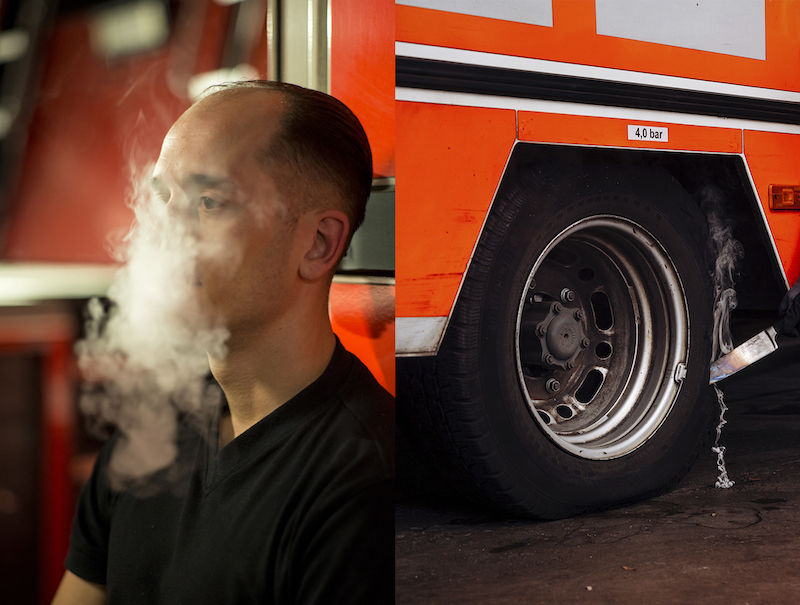 Production stills: To The Moon And Back, 2017; Photo (left): Itai Vinograd, Photo (right): Shai Levy
Production stills: To The Moon And Back, 2017; Photo (left): Itai Vinograd, Photo (right): Shai Levy
ALW: Why their parking lot?
AR: I am a sucker for parking lots. They are in-between spaces, where you are not in and not out. Also, it’s the typical place where many raves used to be, back in the days. This parking lot in particular felt like it needed uplifting, something that would make one’s entrance to the station more alert and a bit surreal.
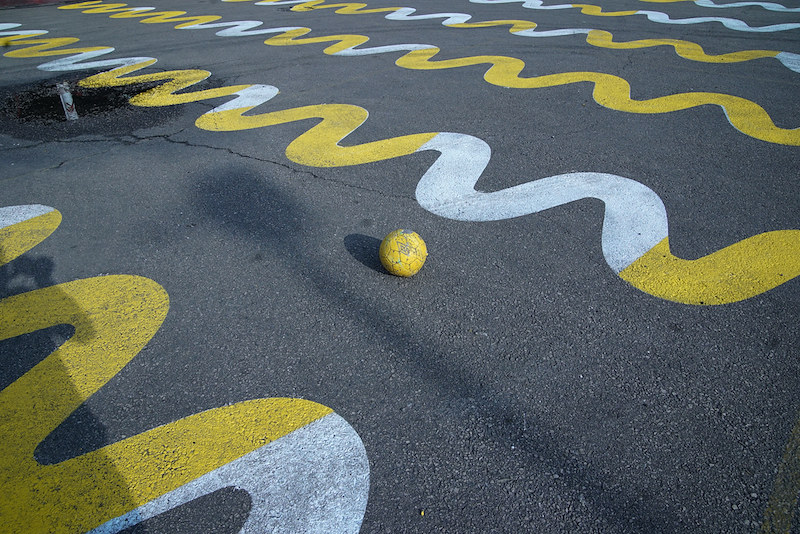 The Curves of Jaffa, Long term install at fire station Jaffa, 2017 Tel Aviv; Photo: Alona Rodeh,
The Curves of Jaffa, Long term install at fire station Jaffa, 2017 Tel Aviv; Photo: Alona Rodeh, commissioned by Tel Aviv Municipality Arts Department
ALW: You have dedicated quite a lot of your work to club culture. When did you begin seeing an aesthetic potential in this culture?
AR: Trying to not sounds nostalgic and old: the early 2000s were the golden age of Techno in Israel and I was taking part, just going regularly and loving it. Around that time, I had my first gallery show, after my BFA in 2005. It was pretty static and I felt something was missing, an “is that all there is” type of feeling. As a result of looking for other paths of expression, I started working with a close friend of mine at the time, Rona Geffen - an excellent electronic musician. We worked as a duo for two-three years. It was great and I was learning how to shake sculptures with vibrations and so on. Working with music is a cultural statement, and in my case it usually involves also a physical reaction. At the moment, I am more focused on light, but also that came initially from nightlife.
ALW: In your exhibition at Künstlerhaus Bethanien in 2014 you transformed parts of the exhibition space into a club, working very much with light and music, like in choreography…
AR: ...That piece was initially about clubs as a “safe place”, creating a historical link between Berlin's tradition of ballrooms in the early 30s’, and the nightclubs around the fall of the wall in the 90’s which organically inhabited abandoned bunkers. I chose to work with “glow in the dark” phosphorus film as the main protagonist of the show. Rødhåd, a Berlin-based techno DJ and producer, created original music for the work. The "glow in the dark" material was charged with light when it was on, and then spread its glow when the light turned off. The music and light were synced on the same loop, behaving as a recorded theatre act.
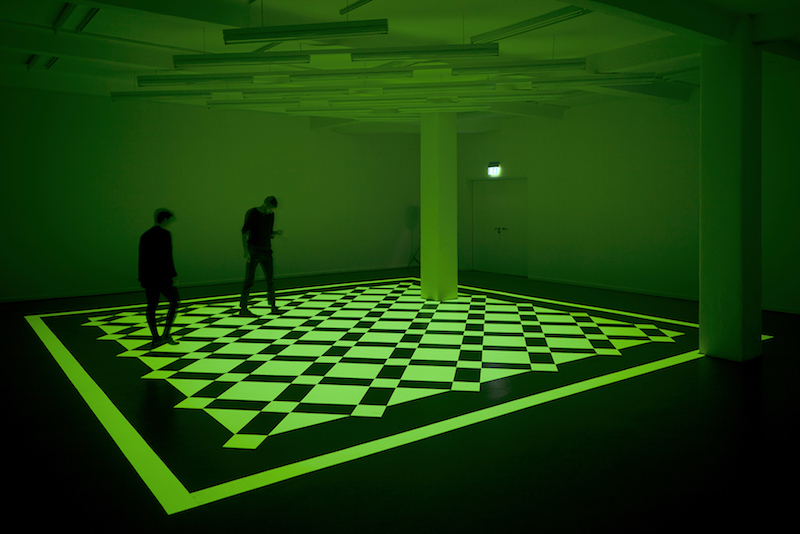 Installation view at Künsterhaus Bethanien, Safe and Sound I, 2014; Photo: Sam Smith
Installation view at Künsterhaus Bethanien, Safe and Sound I, 2014; Photo: Sam Smith
ALW: Doing these choreographies with light and music, you must be giving exhibition spaces a hard time so that everything works out perfectly in the end?
AR: Of course, this is above average for galleries and exhibition spaces. I get under the skin of the architecture, changing basic things like infrastructure of lights and electricity. But I am also pretty well organised and experienced.
ALW: Many of your projects are sculptural, even architectural interventions. Where do you see your own focus in terms of the genres and materials that you utilise, from objects to sound and video?
AR: The foundation of my work is sculpture and installation, but I eventually do almost everything else in addition.
ALW: Traditionally sculptural parts of your work are the abstract figures that you place in different physical positions, bending down, running, kneeling. They look like cardboard boxes with two legs, made of M.D.F. and details in aluminium. These works have both, references to fetishism and to cartoons. Is there an overall theme that the objects refer to?
AR: They are all related to social class, on an abstract level. “The Floor Licker”, the one that is kneeling down, refers to a photo that caught my attention, of a man who demonstrated how he was forced to eat from the ground when he was in detention, thought to be communist in the US in the 30’s. “The Runner" refers to Jesse Owens, the first black runner to win the Olympics. "The Carrier" is packed like a present, an image that carries itself.
 Installation view at Rosenfeld Gallery, Safe and Sound Evolutions Series: the Runner, the Floor Licker, the Carrier, 2015; Photos: Tal Nisim
Installation view at Rosenfeld Gallery, Safe and Sound Evolutions Series: the Runner, the Floor Licker, the Carrier, 2015; Photos: Tal Nisim
"Iron Dome Walking Down the Stairs," puts the whole series in a different context. The Iron Dome is an Israeli air defence system – a patriot that catches missiles in the air. Its success rate is extremely high, above 95 per cent. Despite being such a high technology product, its looks are still very bulky and thick, and in the sculpture I wanted to emphasise that contrast. This piece was shown at Petach Tikva Museum of Art In Israel, along with a sound system spread throughout the museum. There were four very short tracks running, each one starting like a siren and turning into a techno track, created by the electronic musician Muledriver, who is based in Tel Aviv. Every 15 min a different track was bursting in with pretty loud sirens, disappearing after only a minute.
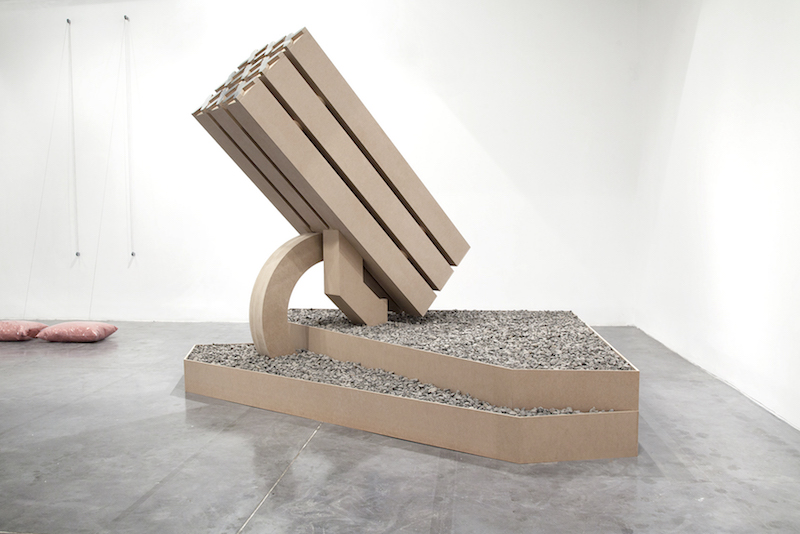 Installation view at Petach Tikva Museum, Iron Dome Walking Down the Stairs, 2015 ; Photo: Michal Bar Or
Installation view at Petach Tikva Museum, Iron Dome Walking Down the Stairs, 2015 ; Photo: Michal Bar Or
ALW: This kind rhythm, the looping of light, sounds and tracks, withdrawing them and letting them return is central to the choreography of most of your exhibitions. Do you consider these sounds as soundtracks for your exhibitions or are they more autonomous?
AR: The idea of soundtrack is maybe too soft for how I work with music, I think. Many times it’s the sound that leads the way.
ALW: Using these choreographic techniques and even moving curtains, your work often reminds me of a theatre rather than an installation. Has your work as a set designer in the theatre inspired your own practice?
AR: Since studying I always did stage design parallel to my work. I think it is easy to see the connection. It is always refreshing and giving me new ideas and experiences that go into my work. It is an extension of my work, a chance to step back and do extremely creative work in different context with a different type of responsibility, supporting other acts I find interest in.
ALW: At the art fair Art Cologne you just presented your work with Christine König Galerie in a "New Positions" solo booth, which also included a moving curtain that – again – brings a very theatrical aesthetic into the exhibition. What was the focus of this presentation?
AR: The presentation at Art Cologne was a very condensed and playful comment on performing presentations. It could be thought of as one installation, although it's made of individual works. There were two photos on the walls, placed on top of blinking lights, which would signal the opening or closing of a reflective fabric drape curtain every 1.5 minutes. The curtain would expose or cover three stretched canvases made of the same reflective material, appearing formalist shapes as a square, a rectangle, a circle. Finally, two sculptures were “watching” the curtain's movements. All the pieces had to do with coverage, exposure, over-exposure, bouncing reflections and camouflage. They all were performing for the visitors their little mini-act, in loops.
ALW: You recently received the opportunity to produce a public artwork on a staircase at a school in Berlin Lichtenberg. What are you proposing to create there?
AR: I chose to treat the main staircase of the Johann-Gottfried-Herder Gymnasium, the busiest place in the building literally as an Autobahn. There will be 6 new graphic works covering the ceilings of the staircases, all in the same three colours: neon yellow, reflective white and asphalt grey. Graphic shapes, inspired by the aesthetic world of street and highway markings, will fill each ceiling with a different graphic texture and together they will create an abstract family of roads and passages. It is my first “Kunst Am Bau” project in Germany, and I hope more will come. It is a very exciting challenge to work in a non-artistic environment.

